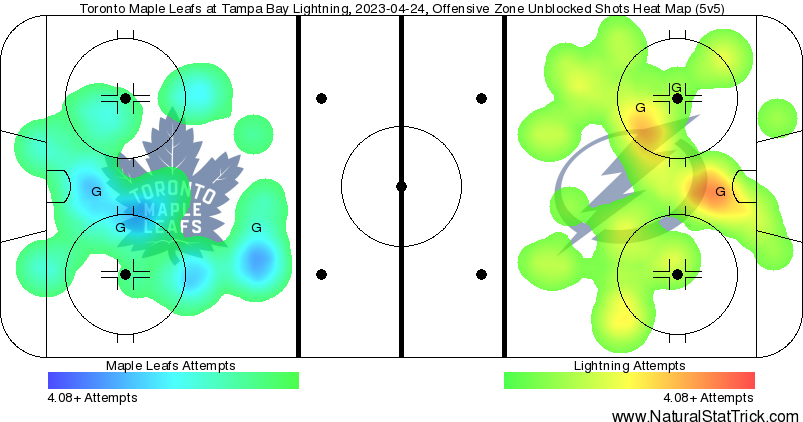This was the fifth time since 2017 that the Maple Leafs went into Game 4 of a series up 2-1. In three of their first four times in this situation, they lost, including to Tampa Bay just last spring.
In that vein, I am constantly reminded of then-Leafs Assistant Coach Paul McLean’s prophetic quote a few years ago: “They got demons in their heads, they got them in their car, they’ve got them under their beds. Everywhere they turn, there’s a demon. The biggest obstacle this team has now is themselves.”
The only way to get over it is to go through it. Face the demons and fight them, one by one. In this case, it was 4-1, with half a period to go. In a series the Leafs were leading 2-1.
And guess what? They won the game.
Your game in 10:
1. The Leafs generally struggled to carry play throughout Game 3, and between games, Sheldon Keefe alluded to the possibility of changing up the lines/lineup. Ultimately, when the puck dropped, he changed nothing, and rather unsurprisingly, nothing changed on the ice, either.
On the first shift of the game, the Leafs started their top line and they got hemmed in the whole shift. The Lightning generated six shot attempts in the first minute of the game alone. While the Leafs did block five of them, it’s a sign of where the puck was and who was controlling the play.
At one point a few shifts later, Darren Raddysh toe-dragged Alex Kerfoot, and Nikita Kucherov just bobbled the pass after. But it felt like the Leafs weathered the storm to some extent, and then Toronto went to a power play. It felt like an opportunity to turn the game around.
It did, but not in the way that you’d expect. The Leafs power play had been great through three games, clicking at over 30 percent. In Game 4, Tampa changed their approach.
The Lightning sold out for the drop pass and pressured relentlessly within the zone. A few times when the Leafs broke through on the entry, they curled to set up thinking they would have time and Tampa would back off. They did not have time.
When the puck went to the point, Tampa skated right up to the point. Compare it to a goal like William Nylander’s power-play goal in Game 1 where he glided from one side of the ice to the other, taking his time until he found a shooting angle he liked before scoring. Tampa turned up the pressure in this one, and the Leafs did not handle the pressure well.
On the first power play resulting in a Brandon Hagel penalty shot, the Lightning forward pressured John Tavares on the half-wall on the entry. It forced a bad pass, and Hagel got to the puck first, chipping it by Morgan Rielly and heading off to the races.
Luckily, the penalty shot attempt itself was awful — a shot right at the pads, basically — and Ilya Samsonov stood tall.
2. After the Leafs went to a power play in which the best chance was a Hagel penalty shot, Toronto then took an awful penalty. For seemingly no reason, William Nylander took Steven Stamkos’ feet out in the offensive zone for a tripping call. It is the exact type of offensive-zone penalty that comes back to burn a team.
The goal pushed the Leafs’ penalty kill down to 66% as they really had no answer for it to this point. Steven Stamkos saw a one-timer blocked by Justin Holl, which has been happening every game; Stamkos has zero power-play points so far, and as much heat as Holl takes, he has actually sealed off that play to this point, which is no easy task.
However, Tampa simply regrouped, and Victor Hedman had all day up top to make a decision. He passed to Nikita Kucherov, who faked a one-timer pass and perfectly put it on the tape for a backdoor tap-in.
It was a great play — and Kucherov has the best fake slap pass in the league — but if you watch TJ Brodie before the goal, he’s doing nothing. He wasn’t in a position to block the shot and the pass obviously went through him. It’s a hard job on that side against an elite player, but he does have to do *something* in that spot.
3. There was little pushback to Tampa taking the lead as the Lightning generally controlled play after scoring. The Leafs had trouble breaking out cleanly and getting the puck through the neutral zone in any real capacity.
This has been a big story in the series — Tampa has suffocated the neutral zone, and the Leafs were having real issues moving the puck up ice. The Lightning’s defense pinch at every opportunity and their third forward covers high exceptionally well. Even when the Leafs do string together a pass or two, they have had little space to do anything with it, at best dumping the puck in and turning over possession.
Eventually, Tampa capitalized on all their pressure. This time, Nikita Kucherov was stopped at the blue line by John Tavares and the puck went to Alex Kerfoot, who tried a drop pass to Morgan Rielly. Unfortunately, Rielly was already moving the other way, and now it was a loose puck that Brayden Point was able to grab. He passed it back to Kucherov, who fooled everyone (myself included) by selling a shot and then passing it over to Mikhail Sergachev for the finish.
William Nylander got caught watching the fake shot — as did Ilya Samsonov — making it a relatively easy goal.
4. At the end of the first period, the Auston Matthews line almost scored, and I almost wonder if it convinced Sheldon Keefe to keep the lines together to start the middle frame, which he did. The Leafs did have more urgency as a team, and that line started the period by putting together a good shift.
Five minutes into the period, who else but Ryan O’Reilly got things going for Toronto. ROR caused a turnover on Sergachev, worked the puck to the point, and everyone’s favourite, Justin Holl, put a shot through that Noel Acciari tipped home.
COOKIE GETS US ON THE BOARD! 🍪 pic.twitter.com/HzVoV56zSm
— Toronto Maple Leafs (@MapleLeafs) April 25, 2023
We noted in the last game that Acciari hadn’t recorded a playoff point in 25 games, but that’s now goals in back-to-back games. It is giving the Leafs some desperately needed depth scoring.
Perhaps related: Pierre Engvall is pointless so far for the New York Islanders in the playoffs.
5. Shortly after, the game really started to change for me as Tampa was still generally controlling play and Keefe finally decided to shake things up, putting Mitch Marner with John Tavares (and Matthew Knies) and moving William Nylander to play with Auston Matthews and Calle Jarnkrok. Alex Kerfoot dropped to play with Ryan O’Reilly and Noel Acciari.
Tavares instantly produced his best shift of the game and even drew a penalty at the end of it. The Leafs went to a power play at 2-1 with a real chance to completely change the game, but again, Tampa’s penalty-killing pressure proved too much, and the Leafs were struggling to set it up and get things going.
Of course, right afterward, Tampa’s top guns forced a turnover on the forecheck and the puck went to Victor Hedman on the point, where he made a great play to wait out Zach Aston-Reese and then rip a shot through the traffic looking for a deflection.
It went off Stamkos’ skate and in, and nobody had any real chance on it. It was just a great play once Tampa created the turnover.
6. At 3-1, even with the Leafs not playing particularly well, the game felt in reach. But with just over a minute left in the second, Tampa caught the Leafs on a long change, made a stretch outlet pass, and went on a quick 2v2 against a Leafs defense that was not set.
The puck got dropped to Alex Killorn, who — from outside the faceoff dot — ripped a shot far side post and in. Ilya Samsonov was screened and it was a great shot, but it’s one where you’d like to think that Samsonov can close off the angle completely. Instead, he was just a little off of square in the net, and Killorn sniped it home.
It felt like a backbreaker at the time.
7. As the third period started, Keefe kept the lines mixed up in order to try to spark something. But there was little to the game. They weren’t creating a ton, and Tampa felt comfortably in control at 4-1.
Halfway through the period, it all started to change. William Nylander hopped on with Mitch Marner and Auston Matthews already on the ice before Nylander took the puck with some speed, gained the zone, sucked in a defender, and dropped the puck to Mitch Marner, who instantly one-touched it over to Matthews.
Auston gets us one back!! pic.twitter.com/gPbErFNGEI
— Toronto Maple Leafs (@MapleLeafs) April 25, 2023
Matthews caught and ripped it as we’ve seen so many times before. It was a really bad play by Tampa; they had their fourth line out there and when TJ Brodie had the puck in the neutral zone, Brodie beat all three of them with a backhand pass to start the whole play.
Brodie really struggled on the night and turned the puck over a number of times. He hasn’t looked like his usual steady self for most of the series, but that backhand pass to slice through Tampa and create the quick-hit 3v2 turned the tide.
8. If Tampa made a mistake, it was starting to hang back and defend the lead. The Leafs are very good at working through prevent defenses.
Before Auston Matthews scored a power-play goal to make it a one-goal game, the Leafs drew a penalty off a play in which Toronto had so much time with the puck. At 5v5, they made a drop pass in the neutral zone to Alex Kerfoot, who was able to gain the zone and dish it off. The Leafs threw it on net and drew a penalty.
That opened the door for the Leafs to really get back into this game on the power play. It did not start well as Tampa went down on a 2v1 of sorts right off the opening draw, and the Leafs failed to set it up in the first minute. They really struggled to adjust to the pressure Tampa was applying, and Hagel — in particular — was giving them fits with his speed.
The only way to combat pressure is to move the puck faster, and the Leafs finally did that in the second half of the power play as Auston Matthews made a clever play to go around the net without the puck, lose coverage, cut in front, and perfectly time his arrival for a deflection into the net.
TONE TIPS IT HOME!!! pic.twitter.com/2QgeSKlOHu
— Toronto Maple Leafs (@MapleLeafs) April 25, 2023
This was just a goal scorer finding a way to score. One of the most impressive things about Matthews has always been that he can score in every which was possible. He is not a one-trick pony or a two-pitch pitcher. He can score in any which way.
It’s also important to note that William Nylander was fully on the same page with Matthews. He held the puck — buying Matthews a second to get to the net — and put it right on #34’s tape.
9. At 4-3, there was blood in the water. The crowd made some noise when the Leafs got their power play at 4-2 to try to urge the team on, but the Leafs scored, and now it was quiet in the building. You could feel the game turning.
On an offensive-zone faceoff drawn by a William Nylander shot (he was around most of the goals in this game, on both sides), the Leafs scrummed the draw and Mitch Marner did well along the wall to keep the puck alive. Keefe had reunited the old favourite John Tavares – Ryan O’Reilly – Marner line, and as Marner helped guide the puck to Morgan Rielly on the point, ROR and Tavares did what they do best: go to the net.
We can see where Rielly was looking when he shot the puck: at ROR driving the net, and Tavares standing on top of the crease screening the goalie.
On the Sportsnet panel, Derek Lalonde noted that the Tampa staff conducted a study and found that Andrei Vasilevskiy was one of the worst goalies at tracking the puck from the point, and I have to think the Leafs have found this out.
There was the Rielly tying goal in this game and the Rielly winner in Game 3. They’ve scored some goals by just throwing the puck on net — from anywhere, really — and getting a deflection or a rebound.
Again, playoff hockey calls for throwing pucks on net, getting traffic, and getting to work. It is too tight to always bank on making plays.
10. Playoff runs need playoff heroes. Auston Matthews with two goals. Morgan Rielly with a late tying goal. In overtime… Alex Kerfoot?!
It was actually surprising to see Keefe go back to his old lines to start overtime. He did the same thing a few years ago against the Habs in Game 6 — he changed the lines, the Leafs tied the game, Keefe put the lines back together, and then they lost.
In this game, Keefe started with the same approach but did mix it up — the big change being William Nylander was out for an offensive zone faceoff with Matthews and Calle Jarnkrok. Matthews won the draw before Nylander swooped in on his offwing, made a great fake-shot move, and looked like he had the open net goal coming before getting tripped up. The penalty ultimately delayed the inevitable.
We noted that the Leafs had trouble with the pressure Tampa was applying on the penalty kill, in particular courtesy of Hagel. It’s noteworthy that the Leafs scored two power-play goals against Tampa’s second unit. You need to find advantages where you can get them, and the Leafs exposed one there in this game.
On the goal, it was the common theme we’ve talked about all series: They simply threw a puck on net with bodies there. Mark Giordano mustered what he could when shooting on his offside, and Alex Kerfoot applied a great tip.
Kerfoot committed a turnover for a goal earlier in the game, and everyone knows about his turnover last playoff series as well as his missed breakaway in Game 6. That had to feel particularly special for him. It sure did for all of Leafs Nation.
SIR ALEXANDER KERFOOT!!! pic.twitter.com/XzD8nVu5Y5
— Toronto Maple Leafs (@MapleLeafs) April 25, 2023






































